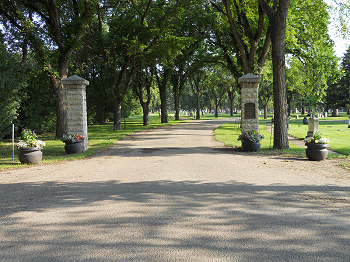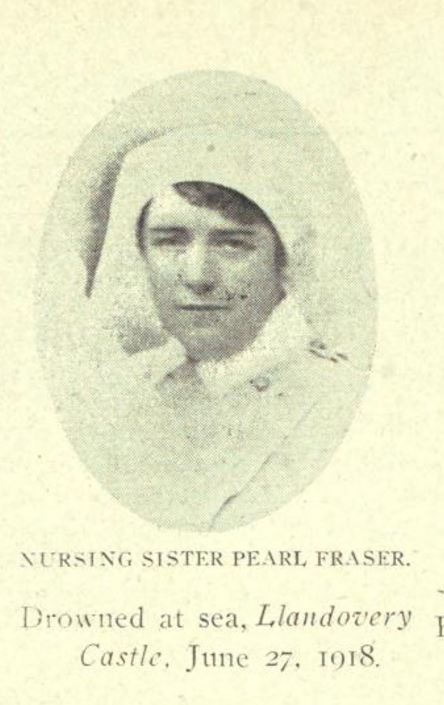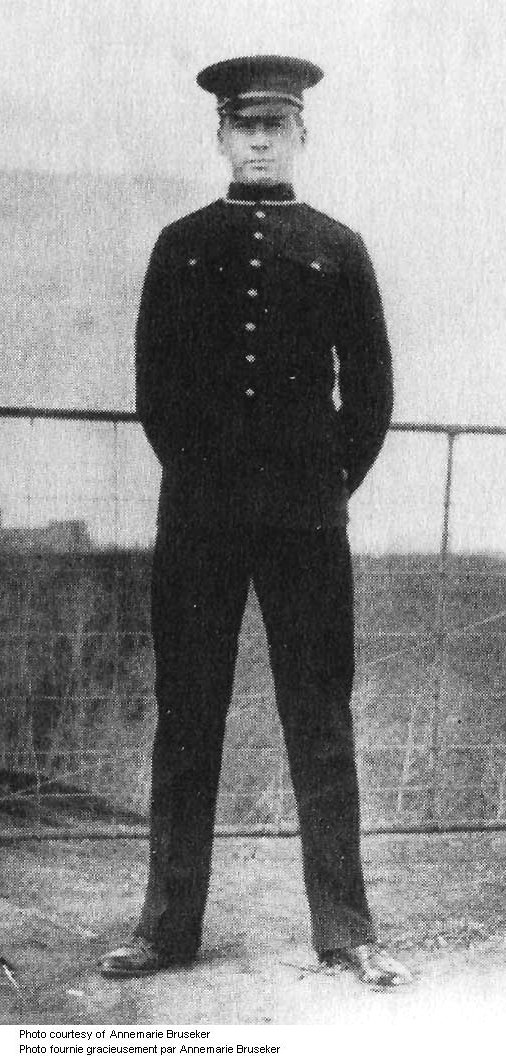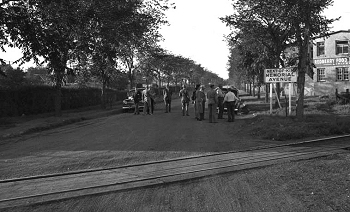Woodlawn Cemetery History
Saskatoon's Woodlawn Cemetery has seen approximately 63,000 burials since it was first opened.
To find the location of your loved one, please use the Cemetery Burial Search.
Woodlawn History
Woodlawn cemetery was established in 1906.
Until 1904, the Nutana (Pioneer) Cemetery south of the river in the original 1883 Temperance Colony settlement, was Saskatoon's only burial grounds. That year, the Summerdale Cemetery opened west of Saskatoon in Smithville, and some burials were done there, as well as at the St. Paul's Roman Catholic Cemetery, which was established by the Roman Catholic Diocese of Saskatchewan in 1905.
By then, it was clear that Saskatoon needed a cemetery north of the river, where most of the people now lived. For one thing, since there was no traffic bridge yet, simply getting to Nutana was difficult. As well, Nutana and Saskatoon -- the present-day downtown -- were separate towns.
A petition submitted to Council in 1905 states:
- "Whereas the Town of Saskatoon has no Cemetery and is obliged to inter its dead in the cemetery situated in Nutana or the cemetery situated at Smithville.
- And whereas the cemetery at Smithville is situated about six miles West from Saskatoon and is too far from Saskatoon to be convenient for its Citizens.
- And whereas the roads leading to the Nutana Cemetery are very poor and unsafe to use a hearse thereon.
- And whereas many people are prevented from attending funerals of their friends at the Nutana cemetry on account of the said roads and at the Smithville cemetery on account of the distance.
- And whereas it is desirable that the Town of Saskatoon should have a cemetery of its own.
- Wherefore your petitioners pray that the Council of the Town of Saskatoon shall provide a suitable cemetery for the said town and your petitioners as in duty bound will ever pray."
The site selected was next to the Roman Catholic cemetery, which was transferred to the City in 1918. Although the last burial in the Nutana (Pioneer) Cemetery was in 1948, Woodlawn was the official cemetery from the time it opened. The first recorded burial was that of an infant, on January 5, 1906. Some unidentified burials are known to have occurred while the Catholic Cemetery was in exclusive use of the site.
Based on current usage, Woodlawn Cemetery is expected to continue as Saskatoon's municipal cemetery for at least another 30 years.
Community Leaders Buried at Woodlawn
The following are biographies of noteworthy individuals of various types who have helped make Saskatoon the place it is today, and who are buried in Woodlawn Cemetery.
Religious Leaders
Archdeacon Herbert Bowles
Bishop James P. Mahoney
Fr. Bob Ogle
Monsignor J.S. Robinson
Bishop A. Roborecki
Politicians and Founders
Anderson, James Thomas Milton
Bowman, Lillian
Clinkskill, James
Edwards, Evelyn
Hopkins, William
Isbister, M.S.H.
Klaehn, P.C.
MacMillan, F.R.
McIntosh, Anna
Sutherland, William Charles
Wilson, James Robert
Wright, Clfford Emerson, O.C.
Young, Alexander M.
The Arts and Education
The Arts:
Education:
Pioneers
Many pioneers were buried at the Nutana Cemetery or the Smithville Cemetery before the creation of St. Paul's Catholic Cemetery in 1905 and Woodlawn's creation in 1906. The following are some of those buried at Woodlawn Cemetery who are recorded in public records as having been pioneers to Saskatoon:
Agnew, Laura Pritchard
Copland, Thomas, Mary & Jessie
Grant, George Weir
Guppy, Fred
Haid, Edward A.
Sanborn, Eleanor
Valens, Dr. John A.
Vandale, William
Business and Labour
Bowman, Aden
Clinkskill, James
Flanagan, James
MacMillan, F.R.
Makahonuk, Glen
Schellenberg, Abram
Other Noteworthy Burials
Addison, Arthur A.
Charpentier, Napoleon
Derkson, J., Hope, R & Hope, K.
Dibble, William Charles
Dunn, Bersha
Diefenbaker, Edna May
Dyer, Elsie Louise
Genereux, Drs. Arthur and George
Hall, Justice Emmett
Memorial Avenue
On June 23, 1923 the Next-Of-Kin Memorial Avenue of Trees was dedicated at Woodlawn Cemetery to commemorate those killed during the Great War of 1914-1918.
It came out of the efforts of two Saskatoon women, Mrs. A.H. Hanson and Mrs. J.W.A. Jarvis, who proposed that a tree planted along a road through the cemetery, along with a plaque, for each individual killed in the war. Both women served on the Education Committee of the Imperial Order Daughters of the Empire, (IODE), which was in full support of the idea. With support from various groups in Saskatoon as well as City Council, the idea became a reality.
Larger Than One War
On that June day in 1923, the Next-Of-Kin Memorial Avenue of Trees was officially consecrated. The ceremony that day was to be the first annual memorial service. Since that time, the yearly event and scope of the Avenue has been expanded to memorialize the family members who died in both world wars, as well as the Korean War, and trees have been planted in many of their memories.
Each year, a ceremony is held at a stone cairn in the Woodlawn Cemetery. At that first ceremony in 1923, 265 trees were dedicated. In the years since, the number has grown to over 1,200. The ceremony and the Memorial Avenue have continued to be a focus of remembrance and gratitude to those who gave their lives in the conflicts that the nation has been involved in.
Last Remaining Memorial Avenue in Canada

Memorial avenues of this type became popular in Canada, the United States and England. A number of these avenues were developed and promoted in Canada. The first is thought to have been in Victoria, B.C. Others were developed in Winnipeg, Manitoba; Calgary, Alberta; Montreal, Quebec; and Thunder Bay, Ontario.
Next-of-Kin Memorial Avenue is the only intact Road of Remembrance remaining in Canada. It was declared a National Historic Site in 1992 and a plaque was unveiled on August 28, 1994.
Trees continue to be dedicated throughout the cemetery at Saskatoon’s annual Decoration Day Service. 2023 marked the 107th anniversary of this long-standing tradition.
Next-of-Kin 100th Anniversary Celebration
On Sunday, June 18th, 2023, the City of Saskatoon hosted a celebration of the 100th Anniversary of Next-of-Kin Memorial Avenue in Woodlawn Cemetery. Joined by the Lieutenant Governor and other dignitaries, along with members of the Canadian Armed Forces, veterans’ organizations and the heritage community, in the commemoration and re-dedication ceremony.
Immediately following the 100th Anniversary commemoration, Saskatoon’s Annual Citizens’ Decoration Day Service was held at the Soldiers’ Memorial Cairn. Decoration Day provides an opportunity to pay tribute to those brave individuals who lost their lives in the service of our country.
Faces Behind the Trees
Behind each tree there is a face, a name, and a life story that deserves to be told.
Each of those commemorated by a tree or buried in Woodlawn Cemetery once lived among us. We should know them as the people they were and the lives they touched through their service and ultimate death. Here are the stories of three of those people of Saskatchewan who were commemorated in the first 266 trees dedicated in 1923.
Nursing Matron Margaret Fraser

Nursing Matron Margaret Fraser, whose mother Bessie Grant Fraser was from Moose Jaw, is commemorated in Section 1, Tree 10, along with the thirteen other Nursing Sisters who died when the Hospital Ship Llandovery Castle was torpedoed and sank in June of 1918. In total, 259 crew, medical staff and passengers were killed in what was a clear violation of the laws of war. Matron Fraser was an experienced nurse, and one of four of the medical staff killed during the sinking who are individually commemorated by trees on Memorial Avenue.
Private Alexander Decoteau

More than 4,000 First Nations and Metis soldiers served in the First World War. In Section 1, Trees 3 and 25 are dedicated to six of those from Saskatchewan who were killed, including Private Alexander Decoteau of the Red Pheasant First Nation near Battleford. The son of Peter and Mary Decoteau, he was the first Indigenous police officer on the Edmonton police force. He was also an accomplished runner, who competed at the 1912 Stockholm Olympics. He was a member of the 49th Battalion, Canadian Expeditionary Force, and was killed at the age of 29 in October, 1917, during the Battle of Passchendaele.
Sergeant Roy Edmunds
Sergeant Roy Edmunds was employed as a clerk in Saskatoon having emigrated from Ontario with this family prior to the war. He was the only child of his parents, Thomas and Alburty Edmunds. He was a member of the 5th Battalion, Canadian Expeditionary Force. In 1916, he received the Distinguished Conduct Medal, at that time the British Empire’s second highest award for bravery. By his selfless actions he saved the lives of his fellow soldiers at the risk of his own. He died at the age of 24, on April 9, 1917, during the attack on Vimy Ridge – the seminal Canadian battle of the First World War.

